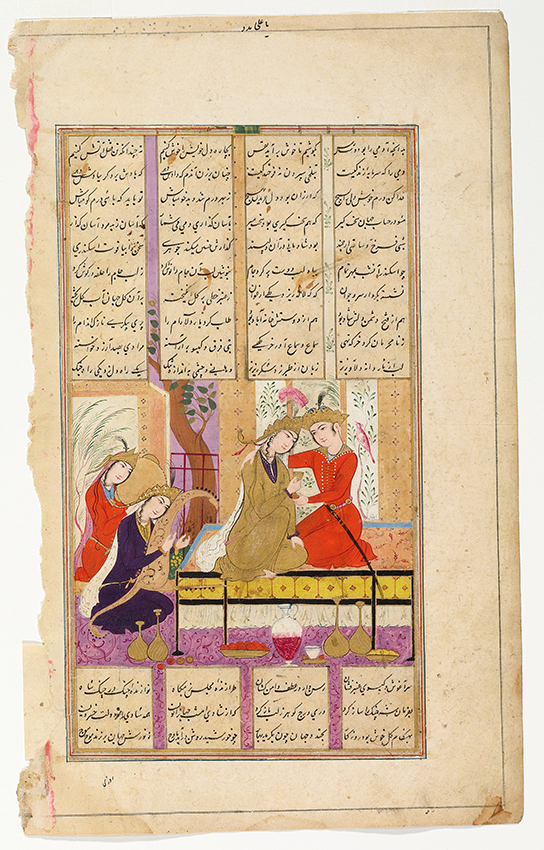Moʿin Moṣavver | Manuscripts | Ḵamsa of Neẓāmi
Manuscript K2, no. 4-67
Eskandar and the Chinese Slave Girl
Ḵamsa, Poem 4, Eskandarnāma (Šarafnāma), Canto 67
Location: Nasser D. Khalili Collection of Islamic Art, London, MSS.1220.2.
Page: 33.9 x 20.7 cm (after Sotheby's
Text area: 25 x 14 cm (scaled)
Painting: 12 x 14 cm. not including extensions between the text columns (scaled)
Text: four column; 13 lines on a 25 line per full page matrix.
Signature: Not signed
Following his defeat of Persia, Eskandar travelled to Arabia and the Caucasus, and then turned his attention to the east, India and China in turn, where the Ḵāqān of Chin gave him a gift of a young Chinese slave girl. After his long and exhausting battle to defeat the Russians, Eskandar chose to unwind in the company of this young Chinese girl. The whole episode serves basically as a vehicle for which Neẓāmi can extol the virtues and need for joy, love and union in one's life.
Certain subjects in Persian painting conformed to a compositional format that remained relaively constant for centuries. Illustrating a king or prince dallying with his wife or female companion is one of them. Moʿin followed this compositional standard -- whether it be Eskandar and the Chinese Slave Girl as shown here, or Eskandar with Rošanak in the Haram, Zāl Meeting Rudāba, or The Marriage of Siyāvoš and Farangis -- only the participants, event, and setting change; the basic format of the composition does not.
Painting references:
Sotheby's (London) Sale, 3 May 2001, Lot 47, Iskandarnama no. 4
Sotheby's (London) Sale, 10 October 2006, Lot 34, Iskandarnama no. 4 (ill.)
Sotheby's (London) Sale, 22 April 2015, Lot 113 (ill.)
Text references:
Persian.Packham.org: (Eskandar-nama, p.764ff, Canto LXVII)
Photo courtesy of Sothebys, with publication permission of the © Nour Foundation and the Khalili Family Trust
Robert Eng
Last Updated: November 20, 2016 | Originally published: November 20, 2016
